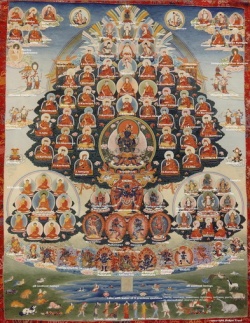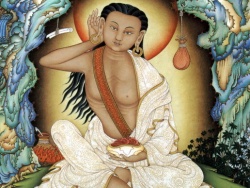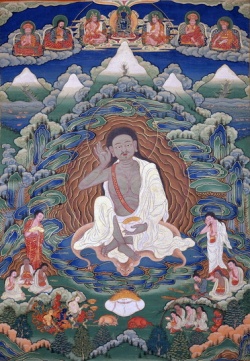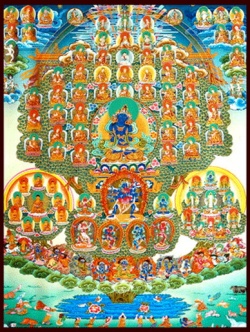Difference between revisions of "Milarepa"
m (Text replacement - "songs" to "songs") |
|||
| Line 10: | Line 10: | ||
When his father [[died]], [[Milarepa's]] uncle and aunt took all of the family's [[wealth]]. At his mother's request, [[Milarepa]] left home and studied {{Wiki|sorcery}}. While his aunt and uncle were having a party to celebrate the impending [[marriage]] of their son, he took his revenge by summoning a giant hail storm to demolish their house, {{Wiki|killing}} 35 [[people]], although the uncle and aunt are supposed to have survived. The villagers were [[angry]] and set off to look for [[Milarepa]], but his mother got [[word]] ([[Tibet's]] Great [[Yogi]] [[Milarepa]]: A {{Wiki|Biography}} from the [[Tibetan]]) to him, and he sent a hailstorm to destroy their crops. | When his father [[died]], [[Milarepa's]] uncle and aunt took all of the family's [[wealth]]. At his mother's request, [[Milarepa]] left home and studied {{Wiki|sorcery}}. While his aunt and uncle were having a party to celebrate the impending [[marriage]] of their son, he took his revenge by summoning a giant hail storm to demolish their house, {{Wiki|killing}} 35 [[people]], although the uncle and aunt are supposed to have survived. The villagers were [[angry]] and set off to look for [[Milarepa]], but his mother got [[word]] ([[Tibet's]] Great [[Yogi]] [[Milarepa]]: A {{Wiki|Biography}} from the [[Tibetan]]) to him, and he sent a hailstorm to destroy their crops. | ||
| − | Many of [[Milarepa's]] [[deeds]] took place in [[Chokyi Dronma]]'s homeland and his [[Life]] and | + | Many of [[Milarepa's]] [[deeds]] took place in [[Chokyi Dronma]]'s homeland and his [[Life]] and songswere compiled by [[Tsangnyön Heruka]], sponsored by [[Chokyi Dronma]]'s brother, the [[Gungthang]] [[king]] Thri [[Namgyal]] De. |
[[Milarepa]] later lamented his [[Evil]] ways in his older years in [[conversation]] with [[Rechungpa]]: "In my youth I committed black [[deeds]]. In maturity I practised innocence. Now, released from both good and [[Evil]], I have destroyed the [[root]] of [[karmic]] [[action]] and shall have no [[reason]] for [[action]] in the {{Wiki|future}}. To say more than this would only [[cause]] weeping and laughter. What good would it do to tell you? I am an old man. Leave me in [[peace]]." | [[Milarepa]] later lamented his [[Evil]] ways in his older years in [[conversation]] with [[Rechungpa]]: "In my youth I committed black [[deeds]]. In maturity I practised innocence. Now, released from both good and [[Evil]], I have destroyed the [[root]] of [[karmic]] [[action]] and shall have no [[reason]] for [[action]] in the {{Wiki|future}}. To say more than this would only [[cause]] weeping and laughter. What good would it do to tell you? I am an old man. Leave me in [[peace]]." | ||
| Line 31: | Line 31: | ||
==[[Lineage]]== | ==[[Lineage]]== | ||
| − | [[Milarepa]] is famous for many of his | + | [[Milarepa]] is famous for many of his songsand [[poems]], in which he expresses the profundity of his [[realization]] of the [[Dharma]]. He also had many [[disciples]], {{Wiki|male}} and {{Wiki|female}}, including [[Rechung Dorje Drakpa]] ([[Ras-chung Rdo-rje Grags-pa]]) and [[Gampopa]] ([[Sgam-po-pa]], Dhakpo Lhaje). His {{Wiki|female}} [[disciples]] include Rechungma, Padarbum, Sahle Aui and [[Tsheringma]]. It was [[Gampopa]] who became [[Milarepa's]] [[spiritual]] successor, continued his [[lineage]], and became one of the main [[lineage masters]] in [[Milarepa's]] [[tradition]]. |
[[File:Karma_kagyu_lineagetree.JPG|thumb|250px|]] | [[File:Karma_kagyu_lineagetree.JPG|thumb|250px|]] | ||
==Unconventional== | ==Unconventional== | ||
| Line 80: | Line 80: | ||
At one point, discouraged, [[Milarepa]] did leave [[Marpa]] to study with another [[teacher]]. When that proved to be unsuccessful, he returned to [[Marpa]], who once again was [[angry]]. But now [[Marpa]] relented and began to teach [[Milarepa]]. And to practice what he was being [[taught]], [[Milarepa]] lived in a {{Wiki|cave}} and devoted himself to [[Mahamudra]]. | At one point, discouraged, [[Milarepa]] did leave [[Marpa]] to study with another [[teacher]]. When that proved to be unsuccessful, he returned to [[Marpa]], who once again was [[angry]]. But now [[Marpa]] relented and began to teach [[Milarepa]]. And to practice what he was being [[taught]], [[Milarepa]] lived in a {{Wiki|cave}} and devoted himself to [[Mahamudra]]. | ||
| − | It was said that his {{Wiki|skin}} turned [[green]] from living only on nettle soup. His practice of wearing only a white cotton robe, even in winter, earned him the [[name]] [[Milarepa]], which means "[[Mila]] the cotton-clad." During this [[time]] he wrote many | + | It was said that his {{Wiki|skin}} turned [[green]] from living only on nettle soup. His practice of wearing only a white cotton robe, even in winter, earned him the [[name]] [[Milarepa]], which means "[[Mila]] the cotton-clad." During this [[time]] he wrote many songsand [[poems]] that remain [[jewels]] of {{Wiki|Tibetan literature}}. |
[[Milarepa]] mastered [[Mahamudra]] teachings and [[realized]] great [[enlightenment]]. Although he did not seek out students, eventually students came to him. Among the students who received teachings from [[Marpa]] and [[Milarepa]] was [[Gampopa Sonam Rinchen]] (1079-1153), who founded the [[Kagyu school]] of [[Tibetan Buddhism]]. | [[Milarepa]] mastered [[Mahamudra]] teachings and [[realized]] great [[enlightenment]]. Although he did not seek out students, eventually students came to him. Among the students who received teachings from [[Marpa]] and [[Milarepa]] was [[Gampopa Sonam Rinchen]] (1079-1153), who founded the [[Kagyu school]] of [[Tibetan Buddhism]]. | ||
Latest revision as of 06:43, 27 January 2016
Jetsun Milarepa (Tibetan: རྗེ་བཙུན་མི་ལ་རས་པ, Wylie: Rje-btsun Mi-la-ras-pa), (c. 1052—c. 1135 CE) is generally considered one of Tibet's most famous yogis and poets. He was a student of Marpa Lotsawa, and a major figure in the history of the Kagyu (Bka'-brgyud) school of Tibetan Buddhism.
Life
Born in the village of Kya Ngatsa – also known as Tsa – in Gungthang province of western Tibet to a prosperous family he was named Mila Thöpaga (Thos-pa-dga'), which means "A Joy to hear." His family name, Josay indicates noble descent, a sept of the Khyungpo or eagle clan.
Sorcery
When his father died, Milarepa's uncle and aunt took all of the family's wealth. At his mother's request, Milarepa left home and studied sorcery. While his aunt and uncle were having a party to celebrate the impending marriage of their son, he took his revenge by summoning a giant hail storm to demolish their house, killing 35 people, although the uncle and aunt are supposed to have survived. The villagers were angry and set off to look for Milarepa, but his mother got word (Tibet's Great Yogi Milarepa: A Biography from the Tibetan) to him, and he sent a hailstorm to destroy their crops.
Many of Milarepa's deeds took place in Chokyi Dronma's homeland and his Life and songswere compiled by Tsangnyön Heruka, sponsored by Chokyi Dronma's brother, the Gungthang king Thri Namgyal De.
Milarepa later lamented his Evil ways in his older years in conversation with Rechungpa: "In my youth I committed black deeds. In maturity I practised innocence. Now, released from both good and Evil, I have destroyed the root of karmic action and shall have no reason for action in the future. To say more than this would only cause weeping and laughter. What good would it do to tell you? I am an old man. Leave me in peace."
Supernatural running
According to the book Magic and Mystery in Tibet by French explorer Alexandra David-Néel, Milarepa boasted of having “crossed in a few days, a distance which, before his training in black magic, had taken him more than a month. He ascribes his gift to the clever control of ‘internal air’.” David-Néel comments “that at the house of the Lama who taught him black magic there lived a trapa [ monk ] who was fleeter than a horse” using the same skill. After witnessing such a monk David-Néel described how:
- "He seemed to lift himself from the ground.. His steps had the regularity of a pendulum.. ..the traveller seemed to be in a trance."
This esoteric skill, which is known as Lung-gom-pa ("Wind Meditation", lung = “wind, gom-pa = “meditation”) in Tibet, allows a practitioner to run at an extraordinary speed for days without stopping. This technique could be compared to that practised by the Kaihigyo Monks of Mt. Hiei in Kyoto, Japan.
Tutelage under Marpa
Knowing that his revenge was wrong, Milarepa set out to find a Lama and was led to Marpa the translator. Marpa proved a hard taskmaster. Before Marpa would teach Milarepa he had him build and then demolish three towers in turn. When Marpa still refused to teach Milarepa he went to Marpa's wife, who took pity on him. She forged a letter of introduction to another teacher, Lama Ngogdun Chudor, under whose tutelage he practised meditation. However when he was making no progress, he confessed the forgery and Ngogdun Chudor said that it was vain to hope for spiritual growth without the Guru Marpa's approval. Milarepa returned to Marpa, and after practising very diligently for twelve years Milarepa attained the state of Vajradhara (complete Enlightenment). He is said to be the first to achieve this state within one lifetime. He then became known as Milarepa, which means the "Mila, the cotton clad one" (the suffix "repa" is given to many tantric yogis since they wear white robes) At the age of forty-five, he started to practise at Drakar Taso (White Rock Horse Tooth) cave - 'Milarepa's Cave', as well as becoming a wandering teacher. Here, he subsisted on nettle tea, leading his skin to turn green, hence the greenish color he is often depicted as having in paintings and sculpture.
Monastery
Pyenzhangling Monastery, also known as Pelgye Ling Gompa, is a small Tibetan Buddhist monastery in a tiny village called Zhonggang, Tibet that is consecrated to Milarepa. It is built around the cave where he once lived. "It was destroyed but has now been rebuilt and decorated by Nepali artisans. This is one of many Caves associated with Milarepa between Langtang and Jomolungma
Lineage
Milarepa is famous for many of his songsand poems, in which he expresses the profundity of his realization of the Dharma. He also had many disciples, male and female, including Rechung Dorje Drakpa (Ras-chung Rdo-rje Grags-pa) and Gampopa (Sgam-po-pa, Dhakpo Lhaje). His female disciples include Rechungma, Padarbum, Sahle Aui and Tsheringma. It was Gampopa who became Milarepa's spiritual successor, continued his lineage, and became one of the main lineage masters in Milarepa's tradition.
Unconventional
Milarepa lived around 950 years ago at the northern slopes of the Himalayas, overlooking the upper reaches of the Brahmaputra river basin, in what is now known as southern Tibet. Buddhism had come to those regions earlier, and it was mixed with the even-older Bon beliefs of that region. At that time, there were lamasaries at some locations regionally. Several years after Milarepa had attained spiritual enlightenment, his long-lost sister, Peta, found him at one of the secluded caves where he meditated alone. She was aghast at his very thin, greenish, and unclothed body, and pleaded with him to take nourishment, which he did. Peta gave him some cloth and thread to make clothes. She then pleaded with him to quit being such a recluse, and come down the mountain and join a monastery or lamasery. That way, he could wear proper clothes and obtain meals. He kindly rejected her suggestion, and described how such trappings of convention would restrict his spiritual development.
Source
The life of Milarepa is one of Tibet's most beloved stories. Preserved orally for centuries, we cannot know how much of the story is historically accurate. Even so, through the ages Milarepa's story has continued to teach and inspire.
Milarepa probably was born in western Tibet in 1052, although some sources say 1040. His original name was Mila Thopaga, which means "delightful to hear." He is said to have had a beautiful singing voice.
Thopaga/Milarepa's family was wealthy and aristocratic, and Thopaga and his little sister were the darlings of their village. However, one day his father, Mila-Dorje-Senge, grew very ill, and he realized he was dying. Calling his extended family to his deathbed, Mila-Dorje-Senge asked that his estate be cared for by his brother and sister until Milarepa came of age and married.
But Milarepa's aunt and uncle betrayed their brother's trust. They divided the property between them and dispossessed Thopaga and his mother and sister. Now outcasts, the little family lived in servant's quarters. They were given little food or clothing and made to work in the fields. The children were malnourished, dirty and ragged, and covered with lice, and the people who once spoiled them now ridiculed them.
When Milarepa reached his 15th birthday, his mother tried to restore his inheritance. With great effort she scraped together all of her meager resources to prepare a feast for her extended family and former friends. When the guests had gathered and eaten, she stood up to speak.
Holding her head high, she recalled exactly what Mila-Dorje-Senge had said on his deathbed, and she demanded that Milarepa be given the inheritance his father had intended for him. But the greedy aunt and uncle lied, and said the estate actually had never belonged to Mila-Dorje-Senge, and so Milarepa had no inheritance. Then they forced the mother and children out of the servants' quarters and into the streets. The little family resorted to begging and transient work to stay alive.
The Sorcerer
The mother had gambled and lost everything. Now she seethed with hatred of her husband's family, and she urged Milarepa to study sorcery. I will kill myself before your eyes, she told him, if you do not get vengeance.
So Milarepa found a man who had mastered the black arts and became his apprentice. For a time the sorcerer taught only ineffectual charms. But the sorcerer was a just man, and when he learned Thopaga's story -- and verified it was true -- he gave his apprentice powerful secret teachings and rituals.
Milarepa spent a fortnight in an underground cell, practicing the black spells and rituals. When he emerged, he learned that a house had collapsed on his family while they were gathered at a wedding, crushing all but two -- the greedy aunt and uncle -- to death. Milarepa thought it right that they survive the disaster so they would witness the suffering their greed had caused.
But the mother was not satisfied. She wrote to Milarepa and demanded the family's crops be destroyed, also. Milarepa hid in the mountains overlooking his home village and summoned monstrous hailstorms to destroy the barley crops.
Villagers suspected black magic and angrily stormed into the mountains to find the perpetrator. Hidden, Milarepa overheard them talking about the ruined crops. He realized then that he had harmed innocent people. He returned to his teacher in anguish, burning with guilt.
Marpa
In time the sorcerer saw that his student needed a new kind of teaching, and he urged Milarepa to seek out a dharma teacher. Milarepa went to a Nyingma teacher of the Great Perfection (Dzogchen), but Milarepa's mind was too turbulent for Dzogchen teachings. Milarepa realized he should seek another teacher, and his intuition led him to Marpa.
Marpa Lotsawa (1012-1097), sometimes called Marpa the Translator, had spent many years in India studying with a great tantric master named Naropa. Marpa was now Naropa's dharma heir and a master of the practices of Mahamudra.
But Milarepa's trials were not over. The night before Milarepa arrived, Naropa appeared to Marpa in a dream and gave him a precious dorje of lapis lazuli. The dorje was tarnished, but when it was polished it shone with brilliant radiance. Marpa took this to mean he would meet a student with a great karmic debt but who would eventually become an enlightened master who would be a light to the world.
So when Milarepa arrived, Marpa did not offer him the beginning empowerment. Instead, he put Milarepa to work doing manual labor. This Milarepa did willingly, without complaint. But every time he completed a task and asked Marpa for teaching, Marpa would fly into a rage and slap him.
Among the tasks Milarepa was given was the building of a tower. But when the tower was nearly finished, Marpa told Milarepa to tear it down and build it somewhere else. Milarepa built and destroyed many towers. He did not complain.
This part of Milarepa's story illustrates Milarepa's willingness to stop clinging to himself and place his trust in his guru, Marpa. Marpa's harshness is understood to be a skillful means to allow Milarepa to overcome the evil karma he had created.
At one point, discouraged, Milarepa did leave Marpa to study with another teacher. When that proved to be unsuccessful, he returned to Marpa, who once again was angry. But now Marpa relented and began to teach Milarepa. And to practice what he was being taught, Milarepa lived in a cave and devoted himself to Mahamudra.
It was said that his skin turned green from living only on nettle soup. His practice of wearing only a white cotton robe, even in winter, earned him the name Milarepa, which means "Mila the cotton-clad." During this time he wrote many songsand poems that remain jewels of Tibetan literature.
Milarepa mastered Mahamudra teachings and realized great enlightenment. Although he did not seek out students, eventually students came to him. Among the students who received teachings from Marpa and Milarepa was Gampopa Sonam Rinchen (1079-1153), who founded the Kagyu school of Tibetan Buddhism.
Milarepa is thought to have died in 1135.
"If you lose all differentiation between yourselves and others,
fit to serve others you will be.
And when in serving others you will win success,
then shall you meet with me;
And finding me, you shall attain Buddhahood." -- Milarepa





